Transportation Research Board
2013
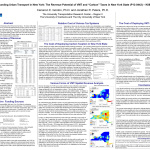 Cameron E. Gordon, Ph.D. and Jonathan R. Peters, Ph.D., Funding Urban Transport in New York: The Revenue Potential of VMT and “Carbon” Taxes in New York State (P13-0443) – K08
Cameron E. Gordon, Ph.D. and Jonathan R. Peters, Ph.D., Funding Urban Transport in New York: The Revenue Potential of VMT and “Carbon” Taxes in New York State (P13-0443) – K08
One the prime engines of transport financing in the US has been fuel taxes. Yet states with a high proportion of urbanization tend to raise less revenue through that means because of lower fuel use due to the higher mass transit use. Nowhere is this more of an issue than in New York State, home to New York City where half of the transit trips in the US take place. This paper examines options that New York State can use to make up for this structural funding problem and achieve desired environmental policy goals as well. VMT (Vehicle Miles Traveled) and Carbon charges are given special attention. The paper concludes with implications for funding reforms nationwide.
2012
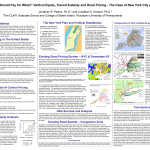 Jonathan R. Peters, Ph.D. and Jonathan K. Kramer, Ph.D., Just Who Should Pay for What?: Vertical Equity, Transit Subsidy and Road Pricing – The Case of New York City (12-3320)
Jonathan R. Peters, Ph.D. and Jonathan K. Kramer, Ph.D., Just Who Should Pay for What?: Vertical Equity, Transit Subsidy and Road Pricing – The Case of New York City (12-3320)
In this paper we examine the vertical equity and cross-subsidization issues associated with the congestion pricing scheme proposed as part of New York City’s PlaNYC 2030. We examine initial travel patterns, user income distribution, and revenue distribution. We find that the perceptions regarding equity which led to the proposal failing to gain enough political support to be implemented are supported by economic analysis of data from various sources. If New York City is to revisit congestion pricing in the future they will need to find a way to spread out the costs and/or concentrate the benefits to those bearing disproportionate burdens.
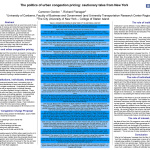 Cameron Gordon, Ph.D., Richard Flanagan, The politics of urban congestion pricing: cautionary tales from New York
Cameron Gordon, Ph.D., Richard Flanagan, The politics of urban congestion pricing: cautionary tales from New York
Congestion pricing in cities is seen as desirable from an economic point of view but difficult politically. A variety of revenue and cost-sharing arrangements have been proposed as ways of creating ballot-box winning coalitions where ‘winners’ outvote losers from a self-interest point of view. However, these proposals generally ignore the roles of institutions, governmental and otherwise, in the control of revenues raised by pricing. These institutions can confound political alliance schemes that aim to build coalitions favoring congestion tolls. This paper examines the failure of New York City to impose a congestion pricing cordon, even though there was significant US Federal government funding available as an inducement to pass it. The role of institutional arrangements turned out to play a key role in this failure, with lessons for the political viability of other proposed schemes.
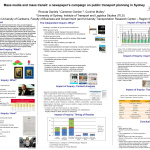 Rhonda Daniels ,Cameron Gordon , Corinne Mulley, Mass media and mass transit: a newspaper’s campaign on public transport planning in Sydney
Rhonda Daniels ,Cameron Gordon , Corinne Mulley, Mass media and mass transit: a newspaper’s campaign on public transport planning in Sydney
The media has an important role in reporting transport news, but it can also engage in transport advocacy and shape transport policy and planning. In 2009, The Sydney Morning Herald newspaper launched an independent inquiry to develop a long term public transport plan for Sydney, with 500 page draft and final reports released in 2010 after community consultation including public meetings and submissions. Most members of the Inquiry team, transport professionals, donated their time to the Inquiry. The paper examines the campaign by The Sydney Morning Herald to develop a long term public transport plan for Sydney, independent of the NSW state government. It reviews the who, what, how, why and when of the campaign. It analyses the impact and influence of the campaign in terms of the contribution to content in the newspaper and impact on government transport policy. The campaign is positioned in the context of civic engagement and social capital models, as well as policy transfer and diffusion. The paper finds that the Herald did not make as full a use of its sponsored Inquiry as it could have, suggesting dual reasons for the campaign of both content generation and readership, and civic engagement and social capital building.
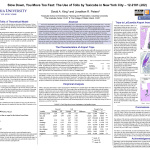 David A. King and Jonathan R. Peters, Slow Down, You Move Too Fast: The Use of Tolls by Taxicabs in New York City – 12-2101 (J02)
David A. King and Jonathan R. Peters, Slow Down, You Move Too Fast: The Use of Tolls by Taxicabs in New York City – 12-2101 (J02)
The for hire automobile market (taxis, limousines, and jitneys) represent an interesting group of automobile users. From the perspective of travel demand, ownership of an automobile is a key determinant in vehicle usage and ownership costs are a large share of the total cost of operating a car. As such, users who pay per use may have very different demand patterns than conventional users. In addition, the use of road pricing to manage automobile demand is of considerable interest both to manage congestion and greenhouse gasses as well as to raise revenue. This paper looks to explore an area that has not yet received much study – the impact of toll prices on route choice and travel demand in for hire car usage. Utilizing Geographic Positioning Systems (GPS) data from medallion taxicabs in New York City, the authors are able to explore the impact of tolls on route choice and travel time by analyzing taxis trips between Manhattan and LaGuardia airport. The optimal route for these trips crosses the East River between the boroughs of Manhattan and Queens at 59th Street, where the drivers can choose either to pay a toll to use the Midtown Tunnel or take the free Queensboro (formerly 59th Street) Bridge. We find in general that paying a road toll does decrease the travel time to airports for these trips, but that the time reduction does not yield a benefit greater than the toll cost. As such, unless users have extremely high values of time, toll road use in taxis represents a cost greater than the benefit.
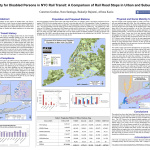 Cameron Gordon, Nora Santiago, Bukurije Bajrami, Afrona Kaziu, Accessibility for Disabled Persons in NYC Rail Transit: A Comparison of Rail Road Stops in Urban and Suburban Areas
Cameron Gordon, Nora Santiago, Bukurije Bajrami, Afrona Kaziu, Accessibility for Disabled Persons in NYC Rail Transit: A Comparison of Rail Road Stops in Urban and Suburban Areas
This paper analyzes the current accessibility of train stations for disabled riders. The analysis, utilizing GIS and data analysis, finds that there is a lack of access in densely populated regions in the New York area compared to service in smaller but wealthier suburban regions. High income communities are better served by accessible stations in the suburbs than those in low income urban communities, despite a higher percentage of disabled and elderly population in the urban areas than in the suburbs.
2011
Cameron Gordon, Ph.D., Bukurije Bajrami, Nora Santiago, Jonathan R. Peters, Ph.D., A Bridge Too Far? Public Policy Issues on Staten Island
Few urban areas are as economically and socially integrated as the New York City borough of Staten Island and the New Jersey communities ofBayonne and Jersey City just across the Hudson River. These strong links are illustrated by travel patterns across a north-south corridor from Staten Island up into Bayonne. Yet transit planning and development policy and implementation has been radically different in the two areas, with slow and, right now, stunted development of transit in Staten Island, New York City, as contrasted with the muscular and systematic approach taken in Bayonne and Jersey City, in New Jersey. This paper analyzes the links between the two areas, describes the different transit policies taken there, assesses the outcomes of these different policies and offers suggestions for ways in which transit and development links could be improved, in particular an extension of the Hudson-Bergen Light Rail (HBLR) into Staten Island. The paper also discusses the interim use of buses as a pre-development phase for LRT or BRT, focusing on the relatively new S89 route in Staten Island that now links directly to the HBLR and which immediately attracted strong ridership.
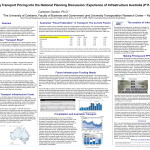 Cameron Gordon, Ph.D., Putting Transport Pricing into the National Planning Discussion: Experience of Infrastructure Australia (P11-0503)
Cameron Gordon, Ph.D., Putting Transport Pricing into the National Planning Discussion: Experience of Infrastructure Australia (P11-0503)
Infrastructure Australia (IA) is a statutory authority of the Commonwealth Government of Australia, established in 2008. IA has three major functions: (1) to provide a list of “nationally significant infrastructure priorities;” (2) to issue guidance on “policy and regulatory reforms desirable to improve the efficient utilisation of national infrastructure networks;” (3) and to assess “options to address impediments to the development and provision of efficient national infrastructure, the needs of users; and possible financing mechanisms.” This poster examines transportation funding needs in Australia and describes how pricing has entered into the national debate via IA.
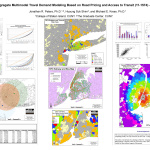 Jonathan R. Peters, Ph.D., Hyoung Suk Shim, and Michael E. Kress, Ph.D., Disaggregate Multimodal Travel Demand Modeling Based on Road Pricing and Access to Transit (11-1574) –D12
Jonathan R. Peters, Ph.D., Hyoung Suk Shim, and Michael E. Kress, Ph.D., Disaggregate Multimodal Travel Demand Modeling Based on Road Pricing and Access to Transit (11-1574) –D12
2010
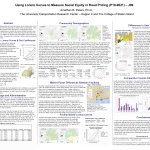 Jonathan R. Peters, Ph.D., Using Lorenz Curves to Measure Social Equity in Road Pricing (P10-0621) – J09
Jonathan R. Peters, Ph.D., Using Lorenz Curves to Measure Social Equity in Road Pricing (P10-0621) – J09
Economic theory offers many techniques that can be used to measure various social policies. Road pricing has a number of impacts on the economic agents that are subject to the pricing regimes. These agents (individuals, businesses and public agencies) alter their behavior in light of these pricing initiatives. The authors will utilize a unique dataset to examine the income distribution using Lorenz Curves and Gini Coefficients of users of various toll facilities (both value priced and fixed rate tolls) in the New York/New Jersey region. The authors will develop empirical estimates of the social equity conditions on the existing priced facilities. Alternative policy solutions to address equity concerns and market power conditions will be discussed.
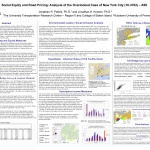 Jonathan R. Peters, Ph.D. and Jonathan K. Kramer, Ph.D., Social Equity and Road Pricing: Analysis of the Overlooked Case of New York City (10-3702) – A06
Jonathan R. Peters, Ph.D. and Jonathan K. Kramer, Ph.D., Social Equity and Road Pricing: Analysis of the Overlooked Case of New York City (10-3702) – A06
Economic theory recognizes two major dimensions of social welfare: efficiency and equity. Efficiency, broadly speaking, is the attainment of maximum output per level of unit input (in theoretical terms, being on the boundary of the production possibilities frontier). Equity broadly refers to the distribution of resources across different groups (and, more subjectively, whether that distribution matches some socially preferred ideal). This paper examines three measures of equity – horizontal, vertical and locational/regional – analyzing data from a unique survey of road users on the New York City Toll Bridges and Tunnels. A particular emphasis is placed on analyzing the burden of individual toll facilities on regional equity.
2008
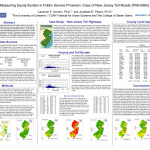 Cameron E. Gordon, Ph.D.and Jonathan R. Peters, Ph.D, Measuring Equity Burden in Public Service Provision: Case of New Jersey Toll Roads (P09-0960)
Cameron E. Gordon, Ph.D.and Jonathan R. Peters, Ph.D, Measuring Equity Burden in Public Service Provision: Case of New Jersey Toll Roads (P09-0960)
Economic theory recognizes two major dimensions of social welfare: efficiency and equity. Efficiency, broadly speaking, is the attainment of maximum output per level of unit input (in theoretical terms being on the boundary of production possibilities frontier). Equity broadly refers to the distribution of resources across different groups (and, more subjectively, whether that distribution matches some socially preferred ideal). This paper examines three measures of equity – horizontal, vertical and locational – analyzing data from the toll collections on the New Jersey Turnpike and Garden State Parkway. The authors find that tolls on these roads are regressive and suggest ways that equity research could be extended into other areas of public service delivery
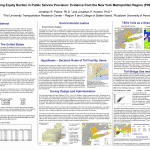 Jonathan R. Peters, Ph.D. and Jonathan K. Kramer, Ph.D., Measuring Equity Burden in Public Service Provision: Evidence from the New York Metropolitan Region (P09-0961)
Jonathan R. Peters, Ph.D. and Jonathan K. Kramer, Ph.D., Measuring Equity Burden in Public Service Provision: Evidence from the New York Metropolitan Region (P09-0961)
Economic theory recognizes two major dimensions of social welfare: efficiency and equity. Efficiency, broadly speaking, is the attainment of maximum output per level of unit input (in theoretical terms being on the boundary of the production possibilities frontier). Equity broadly refers to the distribution of resources across different groups (and, more subjectively, whether that distribution matches some socially preferred ideal). This paper examines three measures of equity – horizontal, vertical and locational – analyzing data from a unique survey of road users on the New York Toll Bridges and Tunnels. Particular emphasis is placed on analyzing the burden of individual toll facilities on regional equity.
